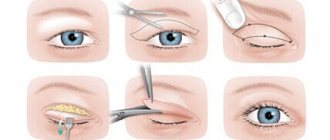Breast reconstruction is a plastic and reconstructive operation aimed at restoring the breast after a mastectomy - surgery to remove the mammary gland in order to cure a woman of breast cancer or prevent the disease. Performing a mastectomy without immediate reconstruction gives a woman severe psychological and physical discomfort (depression, psychosomatic reactions, feelings of inferiority, complexes). Unfortunately, in our country, surgical interventions to restore a lost mammary gland are carried out exclusively on a commercial basis, and alternative replacement methods (such as an external prosthesis or “inlay”) do not give the necessary effect and do not solve the problem from a psychological point of view.
Prices for breast reconstruction
Breast reconstruction after radical mastectomy
for consultation
What is the difference between reconstructed breasts?
During reconstruction surgery, the surgeon strives to bring the final result as close as possible to what it was before the mastectomy, but miracles do not happen. The restored mammary gland will have certain differences:
- The reconstructed breast cannot function as a mammary gland.
- It is almost impossible to absolutely accurately restore the original shape. If both breasts are reconstructed at once, complete symmetry will be ensured. When only one gland is restored, it will be different from the second, healthy breast. Usually these differences are only discovered in the nude.
- After a mastectomy, the breast most often loses the nipple and areola. They can be reconstructed surgically or through imitation (for example, tattooing). With one-stage reconstruction, such procedures are performed later at the request of the patient.
- Reconstructed breasts and healthy breasts feel different to the touch. The reconstructed breast itself partially or completely loses sensitivity.
- Differences in response to external influences and aging. Reconstructed breasts are virtually immune to sagging with age, changes in body weight, and other reasons. As a result, after some time, noticeable asymmetry may appear.
- The difference is in the movement. The muscular system ensures natural movement of healthy breasts. The vibrations of restored tissues obey completely different principles.
Despite these differences, reconstruction allows for an aesthetic appearance, and when wearing a bra they are almost invisible.
Breast reconstruction: the story of one victory
What does a woman experience who has survived breast cancer, amputation, long and difficult treatment, and emerged victorious from this situation? Only she knows this, but the fact that a mastectomy is not a reason to put an end to future life is beyond doubt. And a real case from practice will help you verify this.
The patient was diagnosed with stage 3 breast cancer at the age of 38. One day, in the shower, she simply felt a lump in her chest, turned to a therapist, and he advised her to go to an oncology clinic and undergo an examination.
Several tumor foci were identified. Then there was a long and tedious treatment, 6 months of chemotherapy and a radical mastectomy. Since the disease was diagnosed at a late stage, a large amount of tissue had to be removed and the mammary gland had to be completely removed. But we managed to save all the skin and nipple.
Thanks to this, during reconstructive surgery there was no need to stretch the skin and install temporary expanders. We were able to immediately proceed to installing the implant, avoiding additional surgical intervention.
An anatomical implant was chosen for the operation because it closely matches the shape of the natural breast.
An incision was made in the area of the submammary fold and an implant was installed. The reconstructed breast turned out to be larger in volume than the healthy one, so it was decided to perform a symmetrizing operation. An endoprosthesis was installed in the second breast and the skin was tightened.
Preparing for surgery
At the preparatory stage, the following steps must be taken:
- Consult your doctor before making a decision. The doctor should tell you about all the risks of reconstruction surgery. Talk about the different methods of doing it, their pros and cons. He makes recommendations taking into account the need for radiation therapy.
- Taking tests. With one-stage reconstruction, all the tests necessary to prescribe surgical intervention have already been carried out, and therefore it is additionally necessary to check only the presence of hypersensitivity of the body to the implant material (if choosing the option with prosthetics). With delayed reconstruction, you will have to undergo comprehensive examinations. First of all, you need to make sure that after the mastectomy there are no foci of disease development. Next, laboratory and biochemical blood tests, a general urine test, a blood test for sexually transmitted diseases, AIDS and hepatitis are taken. The degree of blood clotting is determined. An ECG is performed to assess the condition of the heart.
- Compliance with restrictive covenants. 15 days before surgery, you must stop drinking alcohol, smoking, and taking medications that can cause hormonal changes or thin the blood. You will have to give up antibiotics and a number of anti-inflammatory drugs.
The doctor will inform you about all restrictions, and these recommendations should be strictly followed.
In what cases is it impossible to install breast implants after a mastectomy?
Breast reconstruction is suitable for most patients; it can be performed in any clinical cases, with the exception of a number of contraindications:
- recurrence or progression of cancer;
- disturbances in the functioning of the immune system;
- severe heart or vascular disease;
- bleeding disorders;
- hepatitis and other liver diseases;
- the presence of infectious diseases - in this case, the operation is simply postponed until recovery;
- poor physical condition of the patient.
Contraindications are identified at the examination stage.
Moreover, if the patient is undergoing radiotherapy, radiation or hormonal therapy, it is recommended to undergo surgery, since these treatment methods negatively affect the condition of the skin and soft tissues and can cause complications.
For this reason, implantation should be carried out before or after a course of therapy, but not in parallel with it.
How is the operation performed?
Depending on the technique chosen, breast reconstruction surgery is performed as follows:
- Lipofilling. The technique is based on filling the cavity formed after removal of the glandular parenchyma with adipose tissue. The fat composition is extracted from other parts of the body where there are fat layers. Form stability is assessed 3-4 months after the procedure. The technique is suitable when a sufficient amount of skin tissue has been preserved after a mastectomy.
- Endoprosthetics. During breast reconstruction, various types of endoprostheses can be used, which are installed through an incision. The most common are expanders and Becker prostheses. The expander is an isolated cavity into which saline solution is pumped. The liquid is introduced gradually, in parts with an interval of 10-15 days, which ensures gradual stretching of the skin. The entire process of breast formation can take 3-5 months. Becker's prosthesis consists of 2 chambers into which a special gel is pumped.
- Autoplasty. The removed breast parenchyma is replaced with its own tissues. The best option is a latissimus dorsi muscle flap, but this is a difficult and traumatic route. The most commonly used is a musculocutaneous flap from the lower abdomen. The operation to install the flaps lasts 3-5 hours. The final result can be assessed 3-4 months after the operation.
For complete breast reconstruction, a three-stage reconstruction is often used:
- Breast shaping using one of the following methods. The necessary volume and symmetry is ensured.
- Adjustment and correction. The results of the operation can be assessed after 2-3 months. If defects are detected, as well as if there is a need for radiation therapy, corrective surgery is performed after 2 months. The least invasive techniques are used.
- Restoration of nipples and areola. At this final stage, special nipple-areolar plaques are often used.
Breast reconstruction surgery is performed under general anesthesia. Its duration can be from 2 to 5 hours. Difficulties may arise if there is insufficient amount of skin remaining after the mastectomy. In this case, you will have to use donor flaps taken from other parts of the body (for example, buttocks).
There are no clear medical indications for breast reconstruction surgery. The decision is made by the woman herself on voluntary terms. Even for a one-time reconstruction, she must express her desire.
Fadin Alexander Sergeevich plastic surgeon, Candidate of Medical Sciences
How justified is breast reconstruction after mastectomy?
Oncological disease and concomitant therapy is in itself a serious test for the body. And the joy of recovery is often overshadowed by disfigured breasts, loss of femininity and physical attractiveness, because one of the main ways to stop the spread of a malignant tumor was and remains a mastectomy.
It is no coincidence that many women begin their return to normal life and its joys with breast reconstruction. Reconstructive plastic surgery can be one-stage – it is performed simultaneously with the removal of the mammary gland in one operation. Or delayed - some time after the amputation.
Reconstructive surgery, if performed by an experienced reconstructive surgeon, is absolutely safe and, what is especially important and proven by many years of research, does not increase the risk of tumor recurrence.
Mastectomy is performed not only for oncology, but also in a number of other cases:
- breast sarcoma;
- purulent inflammation, mastitis, abscess formation;
- severe trauma to the mammary gland;
- gynecomastia;
- prevention of diseases with a genetic predisposition to them.
In all these cases, it is possible to restore the removed mammary glands.
Rehabilitation
The doctor may recommend this operation if he sees that the patient is seriously suffering psychologically from the defect, and there is a risk of mental disorders. After a mastectomy, a woman may develop various complexes. It seems to her that everyone is paying attention to her defect. They are embarrassed to go to the beach, pool, or bathhouse. Sexual relationships with a partner change especially significantly. In such cases, to eliminate psychological stress, surgery is recommended in the absence of contraindications.
Postoperative recovery lasts from 7 to 15 days, depending on the complexity of the operation. All this time the patient has been in the hospital. During the operation, drainage tubes are installed, which are removed after 5-7 days. The sutures are removed after 12-15 days or dissolve on their own using special threads.
Further recovery is provided outside the hospital for 1 -1.5 months. During this period, it is necessary to wear compression garments. For 2 weeks you can only lie on your back. Only after this period can you roll over on your side. You can lie on your stomach after 30 days and after examination by a doctor.
Significant physical activity, overheating, and visiting bathhouses and swimming pools are prohibited for 2-3 months. You can't play sports. All traces of stitches and scars disappear after 1.5-2 years. During the entire recovery period, the patient must be under medical supervision. After reconstruction, the following temporary side effects are possible: pain and discomfort, decreased sensitivity in areas adjacent to the breast, swelling and temporary asymmetry of the breast due to them.
Nipple tattoo
To restore the shape and volume of the breast, there are many methods of reconstructive surgery, and to restore the aesthetic side - tattooing, as a way to restore the nipple-areolar complex. A specialist uses pigments to graphically recreate their relief and structural features. Tattooing is performed on both breasts to achieve a uniform color. As a rule, at least three colors of implanted pigments are used simultaneously to work on the nipple-areolar complex. The pigments for dermatopigmentation used in the clinic are a certified, modern complex product, do not cause irritant reactions, do not come into contact with organic tissue and are not excreted through the lymphatic system. New generation pigments are resistant to various factors (such as ultraviolet radiation). Stable fixation in the skin is guaranteed by the optimal molecular size (about 6 microns). Modern anesthetics make the procedure painless.






